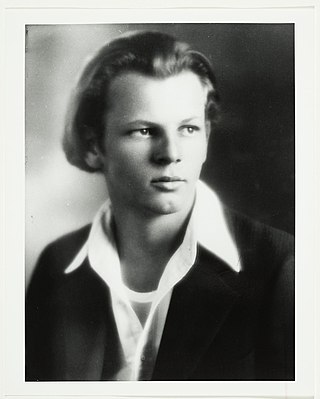
Paul Jackson Pollock was an American painter. A major figure in the abstract expressionist movement, Pollock was widely noticed for his "drip technique" of pouring or splashing liquid household paint onto a horizontal surface, enabling him to view and paint his canvases from all angles. It was called all-over painting and action painting, since he covered the entire canvas and used the force of his whole body to paint, often in a frenetic dancing style. This extreme form of abstraction divided the critics: some praised the immediacy of the creation, while others derided the random effects. In 2016, Pollock's painting titled Number 17A was reported to have fetched US$200 million in a private purchase.

Helen Frankenthaler was an American abstract expressionist painter. She was a major contributor to the history of postwar American painting. Having exhibited her work for over six decades, she spanned several generations of abstract painters while continuing to produce vital and ever-changing new work. Frankenthaler began exhibiting her large-scale abstract expressionist paintings in contemporary museums and galleries in the early 1950s. She was included in the 1964 Post-Painterly Abstraction exhibition curated by Clement Greenberg that introduced a newer generation of abstract painting that came to be known as color field. Born in Manhattan, she was influenced by Greenberg, Hans Hofmann, and Jackson Pollock's paintings. Her work has been the subject of several retrospective exhibitions, including a 1989 retrospective at the Museum of Modern Art in New York City, and been exhibited worldwide since the 1950s. In 2001, she was awarded the National Medal of Arts.

Lenore "Lee" Krasner was an American abstract expressionist painter, with a strong speciality in collage. She was married to Jackson Pollock. Although there was much cross-pollination between their two styles, the relationship somewhat overshadowed her contribution for some time. Krasner's training, influenced by George Bridgman and Hans Hofmann, was the more formalized, especially in the depiction of human anatomy, and this enriched Pollock's more intuitive and unstructured output.

Elaine Marie Catherine de Kooning was an Abstract Expressionist and Figurative Expressionist painter in the post-World War II era. She wrote extensively on the art of the period and was an editorial associate for Art News magazine.
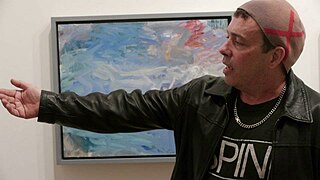
Frank Holliday is an American painter who became known in the New York City art world in the 1970s and 1980s. He is often associated with the East Village scene and associated with Club 57. His early career as an artist included working with Andy Warhol and close associations with artists such as Keith Haring Ann Magnuson and Kenny Scharf.
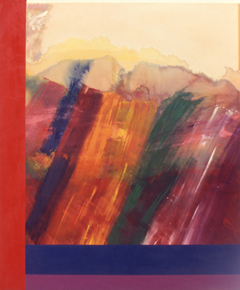
Ronnie Landfield is an American abstract painter. During his early career from the mid-1960s through the 1970s his paintings were associated with Lyrical Abstraction, and he was represented by the David Whitney Gallery and the André Emmerich Gallery.
The Art of This Century gallery was opened by Peggy Guggenheim at 30 West 57th Street in Manhattan, New York City on October 20, 1942. The gallery occupied two commercial spaces on the seventh floor of a building that was part of the midtown arts district including the Museum of Modern Art, the Museum of Non-Objective Painting, Helena Rubinstein's New Art Center, and numerous commercial galleries. The gallery exhibited important modern art until it closed in 1947, when Guggenheim returned to Europe. The gallery was designed by architect, artist, and visionary Frederick Kiesler.
Dorothea Rockburne DFA is an abstract painter, drawing inspiration primarily from her deep interest in mathematics and astronomy. Her work is geometric and abstract, seemingly simple but very precise to reflect the mathematical concepts she strives to concretize. "I wanted very much to see the equations I was studying, so I started making them in my studio," she has said. "I was visually solving equations." Rockburne's attraction to Mannerism has also influenced her work.
Charles Seliger was an American abstract expressionist painter. He was born in Manhattan June 3, 1926, and he died on 1 October 2009, in Westchester County, New York. Seliger was one of the original generation of abstract expressionist painters connected with the New York School.

Edward Dugmore was an abstract expressionist painter with close ties to both the San Francisco and New York art worlds in the post-war era following World War II. Since 1950 he had more than two dozen solo exhibitions of his paintings in galleries across the United States. His paintings have been seen in hundreds of group exhibitions over the years.

Deborah Remington was an American abstract painter. Her most notable work is characterized as Hard-edge painting abstraction.
William E. F. Heeks, Jr., popularly known as Willy Heeks, is an American abstract expressionist painter.

Harry Kramer is an American abstract painter, born in Philadelphia, Pennsylvania. In 1962 he received a BFA from The University of Arts and earned an MFA from Yale University in 1965.

Rosemarie Castoro was an American artist associated with the New York Minimalists. She worked in drawing, painting, sculpture, and other media. She was associated with Minimalism, Conceptual art, and concrete poetry. Castoro was a practitioner of monochrome painting and abstraction. Movement of the human body through physical space was a recurring theme in her work.
Tracy Miller is an American painter. Her large-scale still life paintings of food have been included in more than ten solo shows and more than seventy group shows throughout the United States since 1992. In 2013 her work was the subject of a solo exhibition at the American University Museum and was accompanied by a catalog published by Feature Inc. She was awarded a Guggenheim Fellowship in 2014. She lives and works in Brooklyn, New York.
Nancy Mitchnick is an American painter and educator. She most notably started as part of Detroit's Cass Corridor Group.

Emily Cheng is an American artist of Chinese ancestry. She is best known for large scale paintings with a center focus often employing expansive circular images... "radiantly colored, radially composed". She has won numerous awards including Pollock-Krasner Foundation Fellowship, 2010, New York Foundation for the Arts Fellowship, 1996, Yaddo Residency, 1995, National Endowment for the Arts Fellowship, 1982–1983.
Painting for me, is the evidence of an inquiry…It is the postulation made physical….It is the wall that penetrates….It is the mind reminded. It is the hunch made vivid. It is the reworking of the familiar. It is the shadow of the unfamiliar. It is the acting out of desire. It is the probe of limits. It is the life imaged. It is the eye engaged. Painting is luxury bounded.
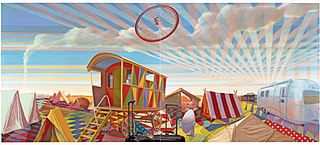
Greg Drasler is an American artist known for metaphorical paintings that mix vernacular imagery and decoration and visual and interpretive conundrums. His work explores the construction of identity and memory through painted subjects that range from elaborately constructed interiors to symbolic common objects to patterned panoramas of the American highway. Although representational, Drasler's work eludes defined aesthetic categories such as realism, incorporating elements of surrealism, abstraction, and postmodern bricolage and recontextualization. In an early Art in America review, Robert G. Edelman wrote that Drasler "shares with Magritte the ability to create images that are both convincing and profoundly disorienting"; Jonathan Goodman described his later paintings as enigmatic puzzles meant to be meditated on, as both "visual metaphors for self" and formal statements existing for the sake of psychological mystery. Drasler has been awarded a Guggenheim Fellowship and grants from the Pollock-Krasner Foundation, National Endowment for the Arts and New York Foundation for the Arts. His work has been shown at the New Museum, PS1, Whitney Museum Stamford, Artists Space and Carnegie Museum of Art, and reviewed or featured in Art in America, Flash Art, New Art Examiner, The Paris Review, and The New York Times. Drasler lives in Tribeca, New York City with his wife, artist Nancy Davidson, and teaches at Pratt Institute.

Harriet Korman is an American abstract painter based in New York City, who first gained attention in the early 1970s. She is known for work that embraces improvisation and experimentation within a framework of self-imposed limitations that include simplicity of means, purity of color, and a strict rejection of allusion, illusion, naturalistic light and space, or other translations of reality. Writer John Yau describes Korman as "a pure abstract artist, one who doesn’t rely on a visual hook, cultural association, or anything that smacks of essentialization or the spiritual," a position he suggests few post-Warhol painters have taken. While Korman's work may suggest early twentieth-century abstraction, critics such as Roberta Smith locate its roots among a cohort of early-1970s women artists who sought to reinvent painting using strategies from Process Art, then most associated with sculpture, installation art and performance. Since the 1990s, critics and curators have championed this early work as unjustifiably neglected by a male-dominated 1970s art market and deserving of rediscovery.
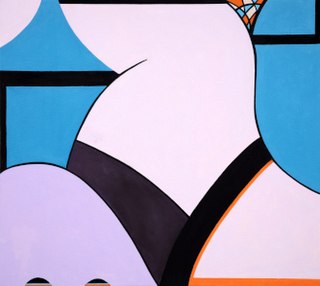
Amanda Church is an American artist known for abstract paintings that reference the human figure and other discernible elements. Her works straddle representational and formalist art traditions, suggesting recognizable body parts, objects, and perspectival elements in an otherwise abstract field. Church's distinctive use of contrasting style elements has been consistently noted by critics such as Hyperallergic's Cora Fisher, who described Church's work as "whimsically overruling the left-right brain dichotomy as well as the traditionally gendered axis that divides geometric and decorative art." Church received a Guggenheim Fellowship in 2015 and a Pollock-Krasner Foundation grant in 2017, among other awards. Her work has been covered in publications such as The New York Times, The Boston Globe, ARTnews, Hyperallergic and Forbes Magazine. Her paintings have been exhibited in major U.S. cities as well as internationally, in galleries and museums such as the Brooklyn Museum of Art and the Aldrich Museum. She lives and works in New York.













